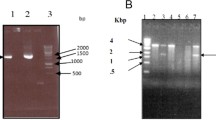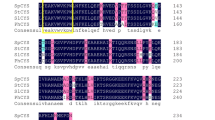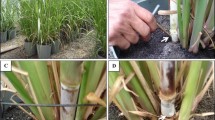Abstract
To become mature and infectious, many viruses and insects require proteolytic cleavage, which can be specifically inhibited by proteinase inhibitors. Oryzacystatin (OC), the first-described cystatin originating from rice seed, consists of two molecular species, OC-I and OC-II, both of which have antiviral activity. These intrinsic rice cystatins show a narrow inhibition spectrum and ordinarily are present in rice seeds at insufficient levels for inhibiting the cysteine proteinases of rice insect pests. In addition, our comparison of inhibitory activity (Ki value) showed that chicken cystatin (Ki 5 × 10-12 M) was more powerful than other cystatins, such as OC-I (Ki 3.02 × 10-8 M) and OC-II (l(i 0.83 × 10-8 M). Chicken cystatin also possesses a wide inhibitory spectrum against various cysteine proteinases. Here, we introduced the insecticidal chicken cystatin 8ene into rice plants to improve their insect resistance. Four highly expressive, independent transgenic lines were identified. Molecular analyses revealed that the transferred 8ene was expressed stably in the independent transgenic lines. Therefore, introducing the insecticidal cysteine proteinase inhibitor 8ene into rice plants can be part of a general development strategy for pest control.
Similar content being viewed by others
Literature Cited
Abe M, Abe K, Kuroda M, Arai S (1992) Corn kernel cysteine proteinase inhibitor as a novel cystatin superfamily member of plant origin. MolecuIar cloning and expression studies. Eur J Biochem209: 933–937
Agrawal GK, Jwa NS, Rakwal R (2000) A novel rice(Oryza sativa L.) acidic PR1 gene highly responsive to cut, phytohormones, and protein phosphatase inhibitors. Biochem Biophys Res Commun274: 157–165
Arai S, Watanabe H, Kondo H, Emori Y, Abe K (1991) Papain-inhibitory activity of oryzacystatin, a rice seed cysteine proteinase inhibitor, depends on the centraI Gln-VaJ-Ala-GIy region conserved among cystatin super-family members. J Biochem (Tokyo)109: 294–298
Auerswald EA, Genenger G, Assfalg-Machleidt L, Machleidt W, Engh R (1992) Recombinant chicken egg white cystatin variants of the QLVSG region. Eur J Biochem209: 837–845
Barrett AJ (1986) The cystatins: a diverse supeffamily of cysteine peptidase inhibitors. Biomed Biochim Acta45: 1363–1374
Brown WM, Dziegielewska KM (1997) Friends and relations of the cystatin supeffamily — new members and their evolution. Protein Sci6: 5–12
Chen GH, Tang SJ, Chen CS, Jiang ST (2000) Overexpres- sion of the soluble form of chicken cystatin inEscherichia coil and its purification. J Agric Food Chem48: 2602–2607
Chen MS, Johnson B, Wen L, Muthukrisnan S, Kramer KJ, Morgan TD, Reeck GR (1992) Rice cystatin: bacterial expression purification cysteine proteinase inhibitory activity, and insect growth suppressing activity of a truncated form of the protein. Pro Exp Purif3: 41–49
Chu C-C (1978) The N6 medium and its applications to anther culture of cereal crops,In Proc Symp Plant Tissue Culture Peking, Science Press, pp 43–50
Colella R, Sakaguchi Y, Nagase H, Bird JW (1989) Chicken egg white cystatin. Molecular cloning, nucleotide sequence, and tissue distribution. J Biol Chem154: 17164–17169
Desmazes C, Gauthier F, Lalmanach G (2001) Cathepsin L, but not cathepsin B, is a potential kininogenase. Biol Chem382: 811–815
Diaz BG, Gross S, Assfatg-Machleidt I, Pfeiter D, Gollmitzer N, Gabrijelcic-Geiger D, Stubbs MT, Fritz H, Auerswald EA, Machleidt W (2001) Cystatins as calpain inhibitors: engineered chicken cystatin- and stefin B-kininogen domain 2 hybrids support a cystatin-like mode of interaction with the catalytic subunit of mucalpain. Biol Chem382: 97–107
Ebert E, Werle B, Julke B, Kopitar-Jerala N, Kos J, Lah T, Abrahamson M, Spiess E, Ebert W (1997) Expression of cystein protease inhibitors stefin A, stefin B, and cystatin C in human lung tumor. Adv Exp Med Biol421: 259–265
Fujimoto H, Itoh K, Yamamoto M, Kyozuka J, Shimamoto K (1993) Insect resistant rice generated by introduction of a modified -endotoxin gene ofBacillus thuringiensis. Bio/Technol11: 1151–1155
Golab K, Gburek J, Gawel A, Warwas M (2001) Changes in chicken egg white cystatin concentration and iso- forms during embryogenesis. Br Poult Sci42: 394–398
Irie K, Hosoyama H, Takeuchi T, Iwabuchi, Wantanabe H, Abe M, Abe K, Arai S (1996) Transgenic rice established to express corn cystatin exhibits strong inhibitory activity against insect gut proteinases. Plant Mol Biol30: 149–157
Janowski R, Kozak M, Jankowska E, Grzonka Z, Grubb A, Abrahamson M, Jaskolski M (2001) Human cystatin C, an amyloidogenic protein, dimerizes through three-dimensional domain swapping. Nat Struct Biol8: 316–20
Kondo H, Abe K, Nishimura I, Watanabe H, Emori Y, Arai S (1990) Two distinct cystatin species in rice seeds with different specificities against cysteine proteinases. Molecular cloning, expression, and biochemical studies on oryzacystatin-I. J Biol Chem265: 15832–15837
Lee S, Jeon J-S, Jung K-H, An G (1999) Binary vectors for efficient transformation of rice. J Plant Biol42: 310–316
Machleidt W, Thiele U, Laber B, Assfalg-Machleidt I, Esterl A, Wiegand G, Kos J, Turk V, Bode W (1989) Mechanism of inhibition of papain by chicken egg white cystatin. Inhibition constants of N-terminally truncated forms and cyanogen bromide fragments of the inhibitor. FEBS Lett243: 234–238
Masoud SA, Johnson LB, White FF, Reeck GR (1993) Expression of a cysteine proteinase inhibitor (oryzacystatin-I) in transgenic tobacco plant. Plant Mol Bio120: 655–663
Michaud D, Cantin L, Vrain TC (1995) Carboxyl-terminal truncation of oryzacystatin-II by oryzacystatin-insensi- tive insect digestive proteinases. Arch Biochem Biophys322: 469–474
Murashige T, Skoog F (1962) A revised mudium for rapid growth and bioassays with tobacco tissue cultures. Physiol Plant15: 473–497
Nagata K, Kudo N, Abe K, Arai S, Tanokura M (2000) Three-dimensional solution structure of oryzacystatin-I, a cysteine proteinase inhibitor of the rice,Oryza sativa L. japonica. Biochemistry39: 14753–14760
Rakwal R, Agrawal GK, Jwa NS (2001) Characterization of a rice (Oryzasativa L.) Bowman-Birk proteinase inhibitor: Tightly light regulated induction in response to cut, jasmonic acid, ethylene and protein phosphatase 2A inhibitors. Gene263: 193–202
Salm T, Bosch D, Honee G, Feng L, Munsterman E, Bakker P, Stiekma WJ, Visser B (1994) Insect resistance of transgenic plant that express modifiedBacillus thuringiensis CrylA(b) and CrylC genes: a resistance management strategy. Plant Mol Biol26: 51–59
Sambrook J, Fritsch ES, Maniatus T (1989) Molecular Cloning: A Laboratory Manual. 2nd ed, Cold Spring Harbor Press, Cold Spring Harbor, NY
Strizhov N, Keller M, Mathur J, Koncz-Kalma Z, Bosch D, Prudovsky E, Schell J, Snen B, Knocz C, Zilberstein A (1996) A synthetic crylC gene, encodinga Bacillus thuringiensis endotoxin, confers spodoptera resistance in alfalfa and tobacco. Proc Natl Acad Sci USA93: 15012–15017
Toriyama K, Hinata K (1985) Cell suspension and protoplast culture in rice. Plant Sci41: 179–183
Turk V, Bode W (1991) The cystatins: protein inhibitors of cysteine proteinase. FEBS Lett285: 213–219
Verdot L, Lalmanach G, Vercruysse V, Hoebeke J, Gauthier F, Vray B (1999) Chicken cystatin stimulates nitric oxide release from interferon-gamma-activated mouse peritoneal macrophages via cytokine synthesis. Eur J Biochem266: 1111–1117
Verwoerd TC, Dekker BMM, Hoekema A (1989) A small-scale procedure for the rapid isolation of plant RANs. Nucl Acid Res17: 2362
Author information
Authors and Affiliations
Corresponding author
Rights and permissions
About this article
Cite this article
Ryu, S., Chung, KC., Chi, YT. et al. Expression of Chicken Cystatin for Improving Insect Resistance in Rice. J. Plant Biol. 44, 205–212 (2001). https://doi.org/10.1007/BF03030353
Received:
Revised:
Issue Date:
DOI: https://doi.org/10.1007/BF03030353




